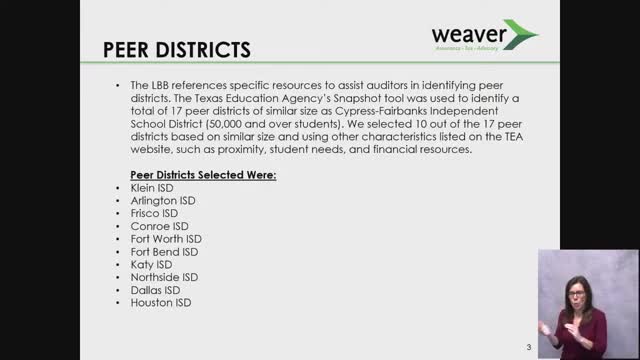District Audit Reveals Strong Performance Amid Funding Challenges
October 04, 2024 | CYPRESS-FAIRBANKS ISD, School Districts, Texas
This article was created by AI summarizing key points discussed. AI makes mistakes, so for full details and context, please refer to the video of the full meeting. Please report any errors so we can fix them. Report an error »

In a recent government meeting, officials discussed the findings of an efficiency audit comparing the performance and financial health of local school districts. The audit utilized a snapshot tool to evaluate 17 districts with enrollments exceeding 50,000 students, ultimately narrowing the focus to 10 peer districts. Klein Independent School District (ISD) reported the lowest enrollment at 53,000, while Houston ISD had the highest at 189,000.
The audit revealed that the district achieved an \"A\" accountability rating with a score of 90, surpassing the peer district average of \"B\" and a score of 88. This marks the 22nd consecutive year the district has maintained an \"A\" rating, reflecting strong financial health and student performance.
Key findings included that the district's average revenue per student was approximately $687 less than both peer districts and the state average. The report highlighted that local funding and state funding often move inversely, impacting the district's financial resources. Notably, a significant portion of federal funding, specifically $736 per student from ESSER funds, is set to expire, raising concerns about future revenue stability.
Operating expenditures per student were also analyzed, showing that the district allocates 66.3% of its budget to instruction, which is higher than the peer district average. Additionally, 85.1% of total expenditures were directed towards payroll costs, with the average teacher salary exceeding both peer and state averages.
The meeting also addressed the district's unassigned fund balance, which stood at $31.50 per student, lower than the peer district average. However, the district exceeded the required three-month operating expense threshold by 40%, indicating a robust financial position relative to its peers.
Board members expressed appreciation for the detailed presentation and discussed the implications of the local optional homestead exemption on tax revenue, which has contributed to the district's financial challenges. Questions were raised regarding the district's budget review processes and the impact of upcoming changes in testing and accountability measures.
Overall, the audit underscored the district's commitment to efficient operations and effective resource allocation, despite facing challenges related to funding and student demographics.
The audit revealed that the district achieved an \"A\" accountability rating with a score of 90, surpassing the peer district average of \"B\" and a score of 88. This marks the 22nd consecutive year the district has maintained an \"A\" rating, reflecting strong financial health and student performance.
Key findings included that the district's average revenue per student was approximately $687 less than both peer districts and the state average. The report highlighted that local funding and state funding often move inversely, impacting the district's financial resources. Notably, a significant portion of federal funding, specifically $736 per student from ESSER funds, is set to expire, raising concerns about future revenue stability.
Operating expenditures per student were also analyzed, showing that the district allocates 66.3% of its budget to instruction, which is higher than the peer district average. Additionally, 85.1% of total expenditures were directed towards payroll costs, with the average teacher salary exceeding both peer and state averages.
The meeting also addressed the district's unassigned fund balance, which stood at $31.50 per student, lower than the peer district average. However, the district exceeded the required three-month operating expense threshold by 40%, indicating a robust financial position relative to its peers.
Board members expressed appreciation for the detailed presentation and discussed the implications of the local optional homestead exemption on tax revenue, which has contributed to the district's financial challenges. Questions were raised regarding the district's budget review processes and the impact of upcoming changes in testing and accountability measures.
Overall, the audit underscored the district's commitment to efficient operations and effective resource allocation, despite facing challenges related to funding and student demographics.
View full meeting
This article is based on a recent meeting—watch the full video and explore the complete transcript for deeper insights into the discussion.
View full meeting
